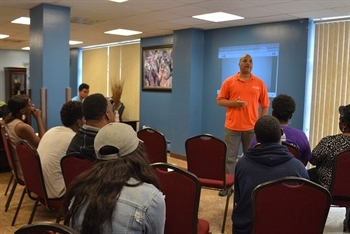Charting the Course for a New Way to Employ Youth
Ian Grant-Funck
Published: July 19, 2017


Every morning between 8:30 and 9:00 am—sometimes 9:05 if the 79 Bus is running behind schedule—thirteen high school students, clad in the brightest fluorescent yellow T-shirts to be found south of Roosevelt, trickle into the Greater Auburn Gresham Community Development Corporation’s (GAGDC) office. They smile and warmly greet the adults at their desks, some of whom are more than thirty years their elders. The elders smile back respectfully as if they were up and coming employees making a fashion statement and not teenagers working (what for many of them is) their first job. This attitude of mutual respect inside an office environment helps the MAPSCorps program achieve one of its main programmatic goals—promoting job readiness.

GAGDC Executive Director Carlos Nelson speaks to the MAPSCorps students and families
The GAGDC is a nonprofit organization that promotes comprehensive community development in all or parts of Auburn Gresham, Ashburn, Englewood, Greater Grand Crossing, Washington Heights, West Englewood, and West Chatham. Through programs promoting education, housing, economic development, health and senior services, the GAGDC works to make Chicago resources more available and Chicago opportunities more equitable.
Groups of students at nine other Community Based Organizations (CBOs) on Chicago’s South and West Sides also gather in the morning for an After School Matters partnered program that provides a variety of benefits to the communities it is engaged in. First and foremost, students learn the proper methods for social science research, fighting the “summer slide” of information that is lost when out of school for three months. They gain meaningful employment thanks to a generous stipend from After School Matters. And, students practice a key skill in STEM (Science, Technology, Engineering and Mathematics), the ability to research and compile data. Moreover, the data they gather doesn’t just sit in a spreadsheet somewhere, completely inaccessible. Instead, the data creates a resource for the whole Southside community.
This resource is the map to which the name MAPSCorps refers. Students record and categorize “community assets” to create a “map” of the economic health of the community they’re working inside of. They record every business, nonprofit and religious organization to form thirteen categories (fitness, dining, retail etc.). This data is then sold to NOWPOW, an organization that helps physicians to “prescribe” treatments to health problems that can’t be solved with a pill—for example identifying the closest grocery store to provide fresh fruits and vegetables, or the closest fitness center to promote exercise.

Group photo of the GAGDC's MAPSCorps students.
Developing research skills early and using them consistently has been identified by college professors internationally as a major predictor of student success—thus MAPSCorps is providing both job-readiness training and college readiness training for its students. In addition to research skills, the program also teaches students how to work as a team and how to resolve conflicts. Atrician Lumumba, one of three undergraduate interns assigned to the GAGDC group echoed this priority: “MAPSCorps provides young people a special alternative to other kinds of jobs; it offers them the opportunity to get engaged with research early and practice teamwork, growing long lasting relationships with their peers.”
The MAPSCorps group at Auburn Gresham even further stresses the importance of research skills through their assigned research question (each of the ten groups has a different research question, organized by the host CBO). Through a partnership between the GAGDC and Thrive Chicago, this group has been asked to determine the most substantial barriers to youth employment in Chicago. They are using resources generously provided by Thrive Chicago, including a built-in technology survey, to complete their research. According to a University of Illinois at Chicago report, Chicago is a national leader in youth unemployment, but these youth are fighting to improve that fact.

MAPCorps working in the GAGDC conference room.
The GAGDC’s MAPSCorps group has identified five key factors: lack of opportunity, racial profiling, scheduling, lack of experience, and personal socio-economic background. Through the MAPSCorps program, however, these youth are directly addressing three of these factors. They are learning time-management and interpersonal skills so that they can easily adjust schedules when possible and effectively state their case to future supervisors when adjustment is impossible. They are gaining an impressive line on their resumes, and with it, the experience necessary to become viable job candidates. Finally, through the “mapping” process, they are gathering data about which businesses and organizations are hiring and when, to guarantee that they’re aware of opportunities when they arise.

The author interviews the three undergraduate interns. (Clockwise from right: Milan Rivas, Ian Grant-Funck, Haya Mohammed, Atrician Lumumba)
The benefits of the MAPSCorps program at the GAGDC go even further than just the student experience, the community engagement and the research question. It provides employment to three undergraduate interns—Atrician Lumumba and Milan Rivas from the University of Chicago, and Haya Mohammed from the University of Illinois at Chicago—encouraging community engagement in diverse young leaders from local institutions. These budding scientists are thrilled to be working for the MAPSCorps program; Haya, a native of Carol Stream, Illinois, said “As a public health major, I am especially excited to work so closely with a community health organization, and it’s a pleasure to develop such close relationships with youth.” The program serves these undergraduates, providing them with training in leadership skills and an understanding of both the inner workings of nonprofits and the people that keep them running.
At GAGDC, MAPSCorps is a long time partner; the program has been hosted there for nine years. Norma Sanders, the Director of Special Initiatives at the GAGDC has been engaged with MAPSCorps since its inception. According to Norma, “MAPSCorps has stayed true to their decade old promise; they hold youth employment as their number one priority.”

MAPSCorps students speak with a store manager about youth employment.
Furthermore, the data gathered by MAPSCorps is useful for community development corporations like the GAGDC. The GAGDC is going to use their data on community assets in the Auburn Gresham neighborhood as a part of the Directory section in the Auburn Gresham Portal, a community resource that provides a free online presence to hundreds of local businesses and fosters connections between neighbors.
This focus on the intimate connections between local communities (especially Community-Based Organizations) and MAPSCorps students was identified by intern Milan Rivas as the greatest asset MAPSCorps has to offer: “A lot of organizations talk about trying to engage with the community, but MAPSCorps serves as a model because its been designed to involve the community every step of the way,” he said. MAPSCorps continues to grow year after year, providing employment and training for more and more high school participants and undergraduate interns, and identifying more and more community assets across the Southside—yet they'll never lose their laser sharp focus on hyper-local community engagement (or the neon shirts).